Rocks, pores and fluids
At an SEG seismic rock physics conference in China several years ago, I clearly remember a catch phrase used by one of the presenters, "It's all about rocks, pores, and fluids." He used it several times throughout his talk as an invocation for geophysicists to translate their seismic measurements of the earth into terms that are more appealing to others. Nobody cares about the VP/VS ratio in a reservoir. Even though I found the repetition slightly off-putting, he succeeded—the phrase stuck. It's all about rock, pores, and fluids.
Fast forward to the SEG IQ Earth Forum a few months ago. The message reared its head again, but in a different form. After dinner one evening, I was speaking with Ran Bachrach about advances in seismic rock physics technology: the glamour and the promise of the state-of-the-art. It was a topic right up his alley, but suprisingly, he seemed ambivalent and under-enthused. Which was unusual for him. "More often than not," he said, "we can get all the information we need from the triple combo."
 What is the triple combo?
What is the triple combo?
I felt embarrased that I had never heard of the term. Like I had been missing something this whole time. The triple combo is the standard set of measurements used in formation evaluation and wireline logging: gamma-ray, porosity, and resistivity. Simply put, the triple combo tells us about rocks, pores, and fluids.
I find it curious that the very things we are interested in are impossible to measure directly. For example:
- A gamma-ray log measures naturally occuring radioactive minerals. We use this to make inferences about lithology.
- A neutron log measures Compton scattering in proportion to the number of hydrogen atoms. This is a proxy for pores.
- A resistivity log measures the conductivity of electrical current. We use this to tell us about fluid type and saturation.
Subsurface geotechnology isn't only about recording the earth's constituents in isolation. Some measurements, the sonic log for instance, are useful because of the fact that they are an aggregate of all three.
The well log is a section of the Thebaud_E-74 well available from the offshore Nova Scotia Play Fairway Analysis.
Part two of this post elaborates on the measurements that are an aggregate of all three.